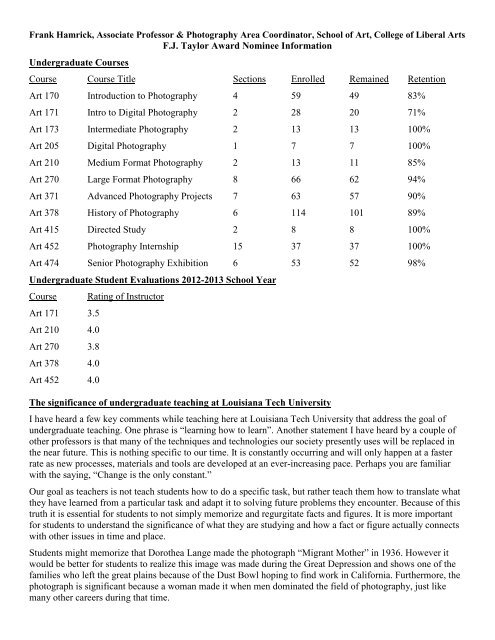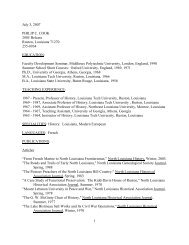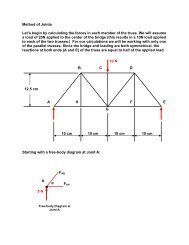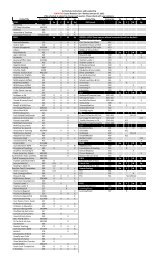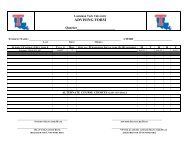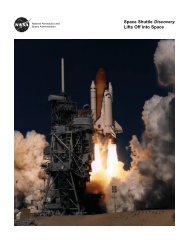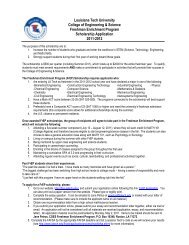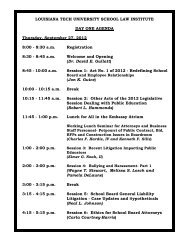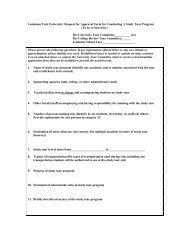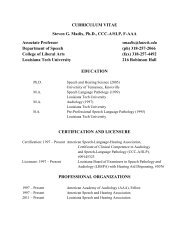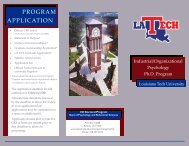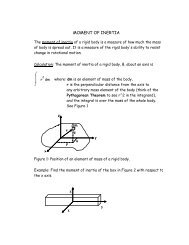Mr. Frank Hamrick - Louisiana Tech University
Mr. Frank Hamrick - Louisiana Tech University
Mr. Frank Hamrick - Louisiana Tech University
You also want an ePaper? Increase the reach of your titles
YUMPU automatically turns print PDFs into web optimized ePapers that Google loves.
<strong>Frank</strong> <strong>Hamrick</strong>, Associate Professor & Photography Area Coordinator, School of Art, College of Liberal Arts<br />
F.J. Taylor Award Nominee Information<br />
Undergraduate Courses<br />
Course Course Title Sections Enrolled Remained Retention<br />
Art 170 Introduction to Photography 4 59 49 83%<br />
Art 171 Intro to Digital Photography 2 28 20 71%<br />
Art 173 Intermediate Photography 2 13 13 100%<br />
Art 205 Digital Photography 1 7 7 100%<br />
Art 210 Medium Format Photography 2 13 11 85%<br />
Art 270 Large Format Photography 8 66 62 94%<br />
Art 371 Advanced Photography Projects 7 63 57 90%<br />
Art 378 History of Photography 6 114 101 89%<br />
Art 415 Directed Study 2 8 8 100%<br />
Art 452 Photography Internship 15 37 37 100%<br />
Art 474 Senior Photography Exhibition 6 53 52 98%<br />
Undergraduate Student Evaluations 2012-2013 School Year<br />
Course<br />
Art 171 3.5<br />
Art 210 4.0<br />
Art 270 3.8<br />
Art 378 4.0<br />
Art 452 4.0<br />
Rating of Instructor<br />
The significance of undergraduate teaching at <strong>Louisiana</strong> <strong>Tech</strong> <strong>University</strong><br />
I have heard a few key comments while teaching here at <strong>Louisiana</strong> <strong>Tech</strong> <strong>University</strong> that address the goal of<br />
undergraduate teaching. One phrase is “learning how to learn”. Another statement I have heard by a couple of<br />
other professors is that many of the techniques and technologies our society presently uses will be replaced in<br />
the near future. This is nothing specific to our time. It is constantly occurring and will only happen at a faster<br />
rate as new processes, materials and tools are developed at an ever-increasing pace. Perhaps you are familiar<br />
with the saying, “Change is the only constant.”<br />
Our goal as teachers is not teach students how to do a specific task, but rather teach them how to translate what<br />
they have learned from a particular task and adapt it to solving future problems they encounter. Because of this<br />
truth it is essential for students to not simply memorize and regurgitate facts and figures. It is more important<br />
for students to understand the significance of what they are studying and how a fact or figure actually connects<br />
with other issues in time and place.<br />
Students might memorize that Dorothea Lange made the photograph “Migrant Mother” in 1936. However it<br />
would be better for students to realize this image was made during the Great Depression and shows one of the<br />
families who left the great plains because of the Dust Bowl hoping to find work in California. Furthermore, the<br />
photograph is significant because a woman made it when men dominated the field of photography, just like<br />
many other careers during that time.
It should be understood that a person is stating they want to improve themselves when they enroll in college. I<br />
am often surprised at what students do not know when they enter the classroom. I sometimes think to myself,<br />
“Someone should teach them about that.” Then I remember I am the teacher and even though photography is<br />
the subject of the course, it does not mean that what I teach them cannot be applied to other areas of life. I have<br />
to keep in mind the things I now know are not common knowledge. They are lessons I learned. They are lessons<br />
that were taught to me. Some lessons were taught overtly, “This is how you do it.” In other situations I learned<br />
by the example the mentor set. I had a mentor guide me when I was in college. I thanked him because I was<br />
aware it was not his obligation to teach me everything. He was going beyond the call of duty. He said there<br />
were people that helped him when he was young and you pay those people back by helping someone else. Now<br />
I am the old man. Now it is my turn to guide some nineteen-year-old kid who is not sure what to do.<br />
We are not forgetting our original teachers by going off and helping someone else. In the end we are all in the<br />
same boat. Our society benefits as a whole when everyone is educated. There is less crime. Our world functions<br />
better because we understand what has come before us. It gives us a better understanding of what will happen<br />
next and even though we cannot know for sure what the future holds, having an education will prepare us to<br />
take what we already know and apply it to new problems as they are presented to us.<br />
Innovation made in undergraduate teaching<br />
The photography curriculum has been revised regularly since I joined the School of Art faculty in the fall of<br />
2006. Originally the 200, 300 and 400 level classes were open to any photography student who had completed<br />
the first two 100 level photography courses. It was challenging to teach lessons applicable to sophomore; junior<br />
and senior students all in the same photography class without discussing techniques or theories too complex for<br />
some students, yet redundant for others. In the end, there were gaps as well as overlapping lessons from one<br />
course to the next.<br />
Former photography professor, Kevin Kennedy and I discussed switching to a linear curriculum. We both felt it<br />
would eliminate existing weaknesses and improve the level of education students receive. Therefore in 2007 the<br />
photography program was revised to become a linear curriculum where each photography course serves as the<br />
foundation and prerequisite for the following photography class. In most cases an undergraduate photography<br />
major takes one photography course each quarter, while supplementing their schedule with art foundation<br />
courses, art electives and general education requirement courses. The photography faculty and students have<br />
found this to be a much more manageable and productive way of structuring the curriculum.<br />
Courses have also evolved over time as new materials, techniques, tools and technology have become available.<br />
Course titles and descriptions in the catalog have been updated as necessary.<br />
The photography curriculum now includes a Photography Elective, which may be fulfilled by taking an<br />
additional photography related course in the School of Art or by completing a photography related internship.<br />
Starting in the 2008-2009 school year, Art 371 – Advanced Problems in Photography and Art 452 –<br />
Photography Internship were first offered.<br />
The course content of Art 371 varies depending on which photography faculty member teaches the course, such<br />
as book arts, art in public spaces, and multi-media. Book arts have been my focus when teaching Art 371. The<br />
class meets the needs of photography majors and minors, but also welcomes students from Communication<br />
Design, Studio Art, Architecture and Interior Design. The course is broad enough for students from these<br />
disciplines to learn concepts and techniques they can apply to their respective majors<br />
The book arts course introduces students to various materials, tools and techniques used to make a variety of<br />
book structures. Attention is simultaneously given to content and concept while learning the technical aspects of<br />
bookmaking. Students learn to consider how these three areas: content, concept and technique work together to<br />
create a small edition of a book addressing a subject of their own choosing. Students consider how text and<br />
images are sequenced to create a logical flow throughout the book. Thought is given to size, structure, typeface,<br />
materials and color choices. In the end, students learn to examine each element of a book to see if it supports or<br />
hinders the book’s purpose. Students learn to notice the things most viewers pay little attention, yet are<br />
important to the impression and feeling a book exudes to a viewer.
Mentoring Undergraduate Students<br />
My goal as a photography professor is to teach students to use what they have learned in class and apply it to<br />
their own circumstances, instead of simply echoing the facts and ideas I have taught them. I find myself<br />
teaching lessons not limited to photography. It might be how to read a ruler, write a lean and cohesive paper or<br />
how to professionally interact with others. If a photography professor can teach lessons beyond photography,<br />
then ideally students should be able to take what they know from photography and apply it to other tasks.<br />
Photography students learn digital and film processes, color and monochrome, fine art and commercial styles,<br />
as well as professional practices necessary in any creative career. I tell my students having a one line resume<br />
that states, “BFA – Photography, <strong>Louisiana</strong> <strong>Tech</strong> <strong>University</strong>” is not enough to exit college and immediately<br />
enter a full time job with benefits. Upon finishing the program, a student’s resume should also include a number<br />
of other accomplishments such as, publications, exhibitions, work experience and numerous skills. All my<br />
students are encouraged to pursue internships and/or jobs relating to their fields of study while in college.<br />
Each photography class I teach involves submitting work to an exhibition or publishing opportunity. Some of<br />
my freshmen students have been paid for having images from their introductory photography class published in<br />
nationally distributed magazines. Many of these students later thank me for making them submit their work<br />
even when they doubted themselves. This also puts parents at ease who are wary of their children pursuing<br />
careers in the arts.<br />
Students are exposed to work by numerous historical and contemporary photographers. It is essential for<br />
students to know what already exists so they do not blindly repeat it. I encourage students to make work that<br />
adds to the visual conversation. Considerable attention is also given to content. The subject of a photograph is<br />
rarely photography. Photographs are about other issues. Students are made aware of this and then work to<br />
successfully convey their own story to viewers.<br />
The photography program balances discipline and freedom. Students must adhere to learning various techniques<br />
and tools, but are free to pursue subject matter important to them. This approach is most evident in the upper<br />
level photography courses where students are allowed to choose from the tools and materials they have learned<br />
to address their own subject matter over the course of an entire year that culminates in an exhibition of that<br />
body of work. Students leave the program not only with photography skills, but also the skills necessary to<br />
promote their artwork and pursue future opportunities, whether it is employment or a master’s degree.<br />
My teaching philosophy is similar to showing someone how to ride a bike. I can demonstrate how a bike<br />
operates and how to ride it. I will help the person get started, but in the end I release them. It is their<br />
responsibility to keep going, but they are prepared and have the freedom to go wherever they want.<br />
Publications, papers and presentations relating to undergraduate teaching<br />
Visiting Lectures – I have lectured at several universities about college, photography and book arts<br />
03/28/2013 Department of Art, <strong>University</strong> of South Carolina, Columbia<br />
02/28/2013 Department of Art & Art History, <strong>University</strong> of Texas at San Antonio<br />
02/21/2013 Online Skype Lecture, Art Department, West Virginia Wesleyan College<br />
11/30/2012 New Orleans Center for Creative Arts, New Orleans, LA<br />
03/16/2012 Lecture & Workshop, Nicholls State <strong>University</strong>, Thibodaux, LA<br />
09/15/2011 Photography Book Seminar, <strong>University</strong> of North Texas, Denton, TX<br />
04/07/2011 Liberal Arts Symposium, <strong>Louisiana</strong> <strong>Tech</strong> <strong>University</strong>, Ruston, LA<br />
10/08/2010 SPE Regional Conference, <strong>University</strong> of Arkansas, Fayetteville, AR
09/30/2010 Hendrix College, Conway, AR<br />
09/22/2010 <strong>University</strong> of Texas at Arlington, Arlington, TX<br />
09/09/2010 Online Skype Lecture, Youngstown State <strong>University</strong>, Youngstown, OH<br />
07/10/2010 Houston Center for Photography, Houston, TX<br />
10/16/2009 Panel Discussion, SPE Regional Conference, Nicholls State <strong>University</strong>, Thibodaux, LA<br />
10/12/2009 Jackson State <strong>University</strong>, Jackson, MS<br />
10/31/2008 SPE Regional Conference, Memphis College of Art, Memphis, TN<br />
05/22/2008 Washington & Lee <strong>University</strong>, Lexington, VA<br />
10/13/2007 SPE Regional Conference, Savannah College of Art & Design, Savannah, GA<br />
Professional Experience - I have served as a consultant and technical editor for several textbooks.<br />
2012 Consultant – Holga Handbook, book proposal by Michelle Bates, Focal Press<br />
2012 Consultant – No Plastic Sleeves, by Danielle Currier, Focal Press<br />
2010 Consultant – Reviewed book proposals for Tablet and Smartphone Apps for Photographers, Focal Press<br />
2010 <strong>Tech</strong>nical Editor – Photography-10 th Edition, by London, Stone & Upton, Pearson/Prentice Hall<br />
2010 <strong>Tech</strong>nical Editor – Plastic Cameras: Toying With Creativity, 2nd Ed, by Michelle Bates, Focal Press<br />
Grants, Awards & Scholarships<br />
2012 <strong>Louisiana</strong> Division of the Arts – Career Advancement Grant – Attended an educational photography<br />
conference in Chicago where I reviewed work from several undergraduate students.<br />
2008 <strong>Louisiana</strong> <strong>Tech</strong> <strong>University</strong> Summer Research Grant – Developed book arts course<br />
2007 <strong>Louisiana</strong> <strong>Tech</strong> <strong>University</strong> Summer Research Grant – Developed internship opportunities for students.<br />
Publications – Here are a few select publications that expose my artwork and philosophy to students.<br />
Artist Portfolio, 500 Handmade Books Volume 2, by Linda Kopp, Lark Crafts – Sterling Publishing Co, 2013<br />
Artist Portfolio, 1000 Artists’ Books by Sandra Salamony, Rockport Publishers – Quarry Books, 2012<br />
Artist Portfolio and Writing, The Elements of Photography: 2nd Edition by Angela Faris Belt, Focal Press, 2011<br />
National Conferences<br />
For the past six years I have attended the Society for Photographic Education’s national conferences. These<br />
conferences have been held in Denver, Dallas, Philadelphia, Atlanta, San Francisco and Chicago. I review<br />
portfolios by undergraduate students at each of these conferences, providing each student with feedback as to<br />
how they can improve their work while in college and what to consider when applying to graduate school.<br />
Thanks for your time.<br />
<strong>Frank</strong> <strong>Hamrick</strong><br />
Associate Professor<br />
Photography Area Coordinator<br />
College of Liberal Arts<br />
<strong>Louisiana</strong> <strong>Tech</strong> <strong>University</strong>


